Genre: Platformer Developer: Psygnosis Publisher: Sony Imagesoft Players: 1 Released: 1994
Psygnosis is one of the most well-remembered game houses of the 16-bit era. Games like Lemmings and Shadow of the Beast boasted impressive graphics and gameplay (well, Shadow of the Beast had neat graphics at least), and its library was of consistently high quality (a few Amiga games notwithstanding). Psygnosis itself has long since faded, but its games are regarded as classics. However, many of its best games are relatively forgotten. Puggsy and Leander are two wonderful Amiga games that nobody really knows about, and its most neglected Genesis (or Mega Drive, as Psygnosis was European) game is probably The Misadventures of Flink.
Created almost single-handedly by Dutch pixel wizard Henk Nieborg (with the help of composer Matthias Steinwachs and programmer Erwin Klobhofer), Flink never got the attention that it deserved in 1994, probably because Donkey Kong Country and Sonic The Hedgehog 3 were released in the same year.
And that’s a shame, because it’s a pretty awesome game.
The story is the usual evil-is-conquering-the-world-and-only-one-hero-can-stop-it cliché, but the visuals and atmosphere more than make up for it. Henk Nieborg’s graphics are incredible, depicting everything from a deep forest to a medieval village to an underground lava tube (again, a cliché, but very well-done) with detail and beauty. Dithering is noticeably absent, giving the graphics an unexpectedly clean look for a Genesis title, but what really blows me away are the scaling, rotation, and transparency effects. I don’t know how Nieborg did it – if I didn’t know better, I’d swear that only the SNES would be capable of this game’s graphics.
Another impressive aspect is the articulated-sprite boss animation, which rivals that of Gunstar Heroes (seriously!) – although there is a bit of breakup from time to time. My only quibbles are that Flink wears a onesie for whatever reason, and it makes him look rather babyish (especially when combined with his round, smiling face); and that the graphics lack the parallax to convey their depicted depth (it’s annoying that misty hills off in the distance are on the same layer as the shacks and huts that are much closer). Also, Flink is the only character with more than two actual frames of animation. Still, it’s a very beautiful game, and the nicely original (for a platformer) theme is a definite step up from the likes of Bubsy and Aero the Acro-Bat.
As for the sound, Flink is rather inconsistent. The music is some of the tinniest, whistliest stuff on the Genesis, and not in an endearing, Tinhead-like way. The faux-medieval melodies are nice – it’s just hard to listen to. The sound effects, however, are great, being clear, distinct, and suitable for their uses. The jumping sound in particular is quite unique, sounding a bit like a slide whistle would if it was a percussion instrument. Other good sound effects include the rumble that treasure chests make when they rise from the ground, and the splash that Flink makes when he jumps into water.
If you are at all familiar with the rest of Psygnosis’ output, you were probably expecting the graphics to be great (more so if you know its Amiga library) and the sounds to be at least decent. The real question here (as it is with all game reviews, but especially when Psygnosis is involved) is, “How does it play?” Well, I’m pleased to report that it’s definitely a step up from the stiffness of Shadow of the Beast and the shallowness of Brian the Lion (a rather overrated Amiga game). Flink’s controls are quite good: Flink himself moves rather slowly – almost as slowly as Greendog at first, but quickly building up a modicum of speed – but his jumps are precise and it’s easy to move him around accurately. The level designs are also great, being large and varied enough to keep the player interested while being linear enough to keep the player from getting lost (there are still lots of bonus areas to find, which is a nice touch). The smooth controls and fun levels, however, are also accompanied by the game’s more innovative mechanics. And these are what set it apart from 1994’s other platformers.
Flink defeats enemies by jumping on their heads, and the mechanic is just as silly here as it was in Super Mario Bros. Rather than simply killing them, though, the first jump merely knocks them out temporarily. After this, Flink can either jump again to kill them, or pick them up and throw them at other enemies, killing them in one hit. It isn’t a mechanic that we haven’t seen before (the thrown enemies behave in a similar way to the Koopa shells in the Mario games), but it’s certainly more prevalent here than in other games. Flink can pick up almost anything, be it a stunned enemy, rock, or treasure chest, and some enemies even require killing by this method.
Also of note is Flink’s powerup system, which is a bit like the time-honored weapon shop, but more involved. As Flink wanders through the game’s multitude of levels, he occasionally finds magical items hidden in the aforementioned treasure chests or carried by certain enemies. These are used in spells that Flink finds written on scrolls (also held in chests and by enemies) from time to time. To complete the spells, though, the ingredients must be mixed in the right order – and the scrolls do not provide this information. This, of course, leads to a lot of Wiz ‘n’ Liz-like trial-and-error mixing (failure to mix the spell correctly will occasionally produce Psygnosis’s obligatory Lemmings cameo) – but the scrolls give the player enough clues that two tries are usually sufficient.
To use the spells, however, Flink must dip into his magic supply. It works like this: killed enemies’ ghosts (at least, that’s what I’m assuming they are) float over to Flink, who collects them in his magic flask. When the flask is sufficiently full, he can use some of its magic to use a spell – the effects of which can be anything from lightning strikes to floating platforms. If Flink is hit, the collected ghosts flutter around the screen, eventually disappearing unless Flink catches them again. If Flink has no magic when he’s hit, he dies. Sure, this mechanic is pretty much the same as Sonic’s, but it’s merely an accessory to the magic system. Sadly, this system will probably be severely underused by the player, as Flink’s standard attacks are easily enough to take down most enemies; even the few times that it’s necessary to use a spell to enter later levels feel tacked-on and unimportant. Nieborg could have made much better use of this mechanic.
With all its faults, though, The Misadventures of Flink is quite an entertaining game. Boasting unbelievable graphics and solid gameplay, along with a few innovations, Flink is definitely one of Psygnosis’s best offerings, despite its obscurity, and it’s well worth your time.
SCORE: 8 out of 10

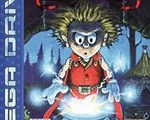
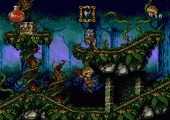
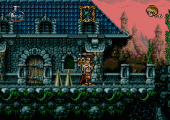

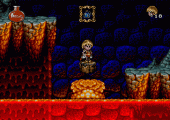
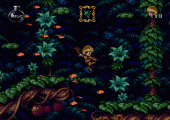
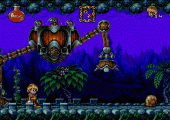
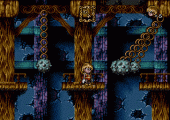
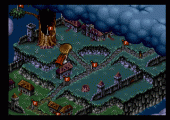
Just discovered this little gem and had to import it from Australia since it was never released in USA (it really starting to fetch a pretty high price). It was worth it. I agree that that graphics is unbelievable for a Genesis game. The art-style reminds me of first Rayman on PS1, another favorite of mine. The soundtrack is a little annoying and seems to keep re-using 2 of the same songs, but I am still early in the game and maybe it will get better. The gameplay does resemble Mario somewhat with jumping on enemies heads and all, but it does have magic and throw system, so there is some variety. 8.5 out of 10 from me.